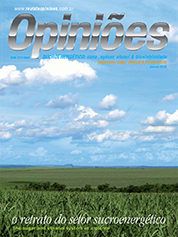Andy Duff
Head of Food & Agribusiness Research of Rabobank International
Op-AA-25
Is it possible to predict?
Powered by promising perspectives for sugar and ethanol demand, coupled with cheap funding during the period 2005 to 2008, Brazil´s cane industry has expanded rapidly in recent years. On the basis of current expectations for the 2010/11 season, the volume of cane milled in Brazil´s Centre/South will have increased by 73% in the last five years - an annual growth rate of 12%.
However, the wave of new capacity entering the industry is now coming to an end. In 2008/09, 30 new mills were commissioned; the estimate for the current 2010/11 season is 10 new mills, and just 5 mills in 2011/12. Low international sugar prices plus an appreciating exchange rate in 2007 and much of 2008, combined with the impact of the global financial crisis at the end of 2008, have meant that while the industry´s output grew rapidly, its general financial situation had deteriorated considerably by 2009, triggering a wave of mergers and acquisitions, which has continued into 2010.
After the turbulence of recent years, many participants in the industry are currently more interested in investing in increasing the efficiency of existing operations than in pursuing further expansion. Nevertheless, despite the current slowdown in investment and capacity expansion, there is much more growth to come over the next decade.
According to Unica’s (the Brazilian Sugarcane Industry Association) projections, by 2020 the Brazilian sugar and ethanol sector should be processing around one billion tonnes of cane a year. This suggests that, between now and then, around 350 million tonnes of new milling capacity needs to be built. Assuming an approximate cost of investment at USD 90/mt capacity (USD 75/mt for factory investment and another USD 15/mt for field investment), this indicates a required investment of some USD 30 billion over the coming ten years.
Where will these funds come from and who has the best chance of accessing them? After the boom-and-bust of recent years, lenders and investors are likely to remain cautious. Factors such as:
1. presence & experience in the market;
2. high standards of corporate governance and transparency;
3. strong balance sheet and cash flow;
4. strong guarantees (fixed assets, export contracts), and
5. enhanced visibility/predictability of revenue stream and margins (for example, electricity sales to the grid) are likely to be important influences on funding availability and cost.
Under these circumstances, large well-established players with sophisticated financial management may well have an enhanced funding advantage, giving them more scope to pursue expansion and market share via organic growth and acquisitions. Mid-size and small players may find it increasingly hard to keep up, and concentration in the sector could be further encouraged.
This trend may be reinforced by the increasing involvement of the petroleum sector in the Brazilian cane industry. The recent decisive entry into the sector of two petroleum giants (Shell with Cosan, and Petrobras with Açúcar Guaraní and with São Martinho) suggests that oil companies are now ready to put their own resources, enormous by the standards of the cane sector, into the biofuels business.
What about the future business environment? For the foreseeable future, demand for sugar and ethanol will drive the sector – though in the longer term, there is certainly potential for new markets to develop for cane-based products, such as advanced biofuels, bioresins and bioplastics. The sugar and ethanol markets are typical commodity markets, and are likely to be as volatile and cyclical in the future as they have been in the past.
However, the long term trend in world sugar prices should reflect the marginal cost of production. This in turn should reflect the cost of production of sugar in a new Brazilian mill, because much of the additional sugar that needs to be produced to satisfy rising global demand will be produced in Brazil. In such a business environment, long term sustainability and profitability means not just surviving at the long term trend price, but surviving comfortably through the inevitable volatility and cyclical downturns in the market. Among the key success factors required for this are
1. cost leadership, using economies of scale, clusters, etc;
2. solid risk management, and
3. some diversification of revenues outside commodity markets, for example electricity sales.




